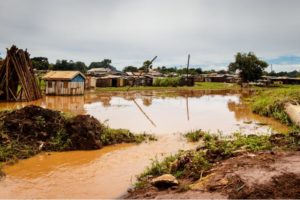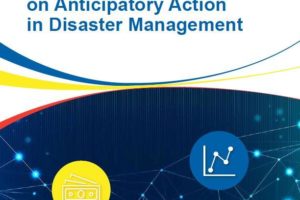Designing a flood early warning system (FEWS) for West Africa

The great West African drought that started in the 1970s was undoubtedly a turning point in the region’s environmental discourse. It is well recognised as one of the most significant climate-driven disasters in recent history. The event was the onset of an era of rainfall uncertainty and variability, driving recurring floods and droughts across the region.
West Africa, an agglomeration of 16 countries, spans from the dense humid forests of the south to northern Saharan desertscapes (Figure.1). The region’s rainfall cycle is controlled by the Intertropical Convergence Zone. Changes in rainfall patterns have been attributed to climate change as well as land-use changes. ‘The Sahelian paradox’, is the increase in river flows despite reducing rainfall seen in many river basins. The complexity of hydrological and regional wind systems make it difficult to accurately predict long-term rainfall trends and their consequences.
The Economic Community of West African States (ECOWAS) has invested significantly in drought management in the past. However, these nations have been unprepared for the sudden rise in floods over the last decade. In 2020, a year of particular flood severity, 198,000 homes were destroyed or damaged, 96,000 people were displaced and 2.2 million people were affected across West and Central Africa. If no action is taken, an estimated 32 million people will be forced to migrate internally by 2050.
In response to increasingly frequent disasters, many early warning systems for floods have been launched in West Africa. Flood early warning systems are typically designed around four broad considerations: knowledge of risks, monitoring and warning, response capacity and communication. These systems monitor real-time atmospheric conditions to predict weather conditions, and warn people and governments on how and when to act to minimise disaster impacts. Such tools are especially effective when emergency action plans are laid out and agreed upon by different stakeholders.
Existing flood early warning systems (FEWS) have not been able to meet stakeholders’ needs regarding timeliness of information, geographical coverage, uninterrupted communication, accuracy and open ownership. To increase the adoption, effectiveness and usefulness of warning systems, stakeholder engagement in the design phase is crucial. Generally, empirical evidence on the effectiveness of participatory processes in sustainability science and disaster planning has been weak.
The EU Horizon 2020 FANFAR (Reinforced cooperation to provide operational flood forecasting and alerts in West Africa) project aimed to change this. Within FANFAR’s broader aim of developing a FEWS, our research focused on designing such a system in collaboration with 50-60 stakeholders from 17 countries. Stakeholders included emergency managers, representatives from regional and national hydrological services and river basin institutions. Two key participating organisations were the West African consortium members AGRHYMET Regional Center and the Nigeria Hydrological Services Agency.
We used a research approach called Multi-Criteria Decision Analysis (MCDA). MCDA helps find possible solutions in situations where multiple, often conflicting, criteria need to be considered when assessing options. The first research question investigated what a good FEWS looks like in the West African context.
The second and broader objective explored the relevance of using MCDA as a participatory and transdisciplinary approach for a large project potentially benefiting millions of people across several countries. The participatory process was designed around three key project phases and implemented through a series of stakeholder workshops (Figure 2).
During the first phase of co-designing, stakeholders developed a joint understanding of the problems of existing flood warning systems. They came to a consensus on objectives that were needed to prioritise functions in the warning system. The second phase focused on knowledge co-production, where scientific and societal perspectives and practitioners’ expertise from different sectors were integrated.
The aim of MCDA was to design a FEWS in a way that best meets the objectives and preferences of all stakeholders. During the final stage of co-dissemination and evaluation, the aim was to translate the knowledge produced into solution-oriented and scalable products.
From the co-designing phase, ten objectives emerged as fundamentally important to stakeholders, clustered into four groups. These were clarity and accuracy of information, reliable and timely information access, affordability of production development and operation, and long-term financial and operational sustainability of the early warning system (Figure 4). The ten objectives received different weights depending on their importance to stakeholders.
Of the eleven versions of FEWS that were created by stakeholders and the FANFAR consortium, three were assessed to be well-performing and robust. One version, for example, could function with relatively minimal resources such as poor internet connectivity, unstable power supply and a limited number of skilled personnel. It suggests the FEWS should be simple and robust rather than incorporating many complex features.
MCDA was particularly helpful in focusing on stakeholders’ values. It helped in navigating and reconciling conflicting stakeholder preferences. MCDA was also helpful for knowledge co-production by providing clarity on stakeholder preferences, incorporating diverse perspectives from different disciplines and assessing different FEWS versions despite uncertain data.
The uptake of the FANFAR FEWS in West Africa will depend on a multitude of other factors. These include operational data collection, strategies to increase local capacity, securing long-term funding for operations, maintenance, and technical development. Local and regional governance structures also play an important role. However, because it was built on a common understanding of contextual challenges among diverse stakeholders, we believe the resultant FEWS will be useful to stakeholders from different regions, sectors and professional backgrounds.
[Source: Lienert, J. et al. (2022) 'How to co-design a flood early warning system (FEWS) for West Africa' Water Science Policy, doi: https://dx.doi.org/10.53014/CBJJ5560]




